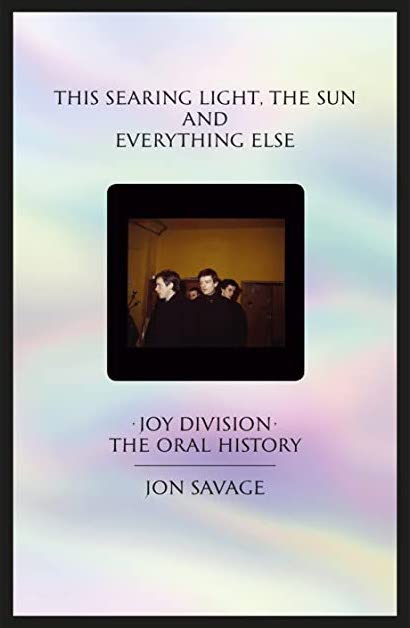This is the whole story, told by those who were on the inside and the outside, guided by the experienced hand of Jon Savage, whose writings on English punk are the ones you need to study first and foremost. Add this entertaining and insightful oral history of this band from the suburbs of Manchester to his masterworks and while you’re at it brother, mark This Searing Light, the Sun and Everything Else: Joy Division, the Oral History down as the definitive history of the band.
As Joy Division (originally called Warsaw), singer Ian Curtis (Macclesfield), guitarist Bernard Sumner (Salford), bassist Peter Hook (Salford) and drummer Stephen Morris (Macclesfield) — released two highly treasured albums, along with an EP and the odd single or two during their 1977-1980 existence. The group’s legend was sealed when Curtis hung himself the night before the band were set to leave for their first tour of the United States in May of 1980.
Savage assembles remembrances from the living members of the group (who you may recall went on to form a somewhat successful band called New Order), as well as impresario Tony Wilson, who was an influential TV presenter and general catalyst for original art.
Also excellently presented are quotes from those were integral to the Manchester scene, and the insights they offer into the actions and personalities of two key players in the story who are now (hopefully) resting in power — manager Rob Gretton and producer Martin Hannett — are vital to the story.
Assembled in chronological order and aided by just the proper amount of visual aids (posters and classic band photos), Savage winnows the story down to the basics and allows the words to breathe on their own. And importantly, he chooses the words so well that drama or angst never overwhelm the narrative. And the words? Fascinating:
“Tony Wilson: It was all four of them, without any question. People talk about drummers being important to groups, and there’s no Joy Division without Stephen driving it that way and Bernard’s slash guitar, and clearly the core melodic element is Hooky’s high-fret playing of that bass, which no one had done before then. All of them had something to say, and they’d all been freed by the Pistols. And I don’t understand why that should glue together, that amalgam of those four people – it wasn’t just Ian, it was all four of them.”
Oral histories can be problematic, mainly when the authors allow the interviewees to openly question the recollections of others, or when the focus turns from historical recall to personal axe grinding and long-smoldering grudges. (If that sort of thing floats your boat, be sure to read Hook’s Unknown Pleasures: Inside Joy Division as well as his hilarious The Hacienda: How Not to Run a Club.) But Savage is too experienced to include that sort of sideline entertainment. What’s here is the good stuff, the heart of the story and the emotions and decisions that shaped it. And his use of period material — especially from live reviews as well as interviews Curtis gave — is judicious and effective.
“Charles Shaar Murray, New Musical Express, July 7, 1979: Onstage, Joy Division ram dark slabs of organised noise at the audience while a scarecrow singer moves like James Brown in hell. Acidrock a decade or so on. It is whispered that acid enjoys considerable allegiance from a lot of the young postpunks in Manchester. As the bassist triggers a synthesiser and a skin breaks on the snare drum and the band’s sound begins to resemble Awful Things carved out of smooth black marble, who could argue?”
One revelation the book unlocked for me was that Wilson, Gretton and the three others in the band didn’t take Curtis’ epileptic fits as seriously as they should have. Not that they should be blamed for it. Curtis himself played them down and insisted he was fine and it’s abundantly clear he wanted to be in a band more than anything in the world. But his illness, along with the stress of a failing marriage, eventually turned his life into one of enormous stress, pain and fear. He emerges from the pages as a deeply sensitive human being who wanted nothing more than sing his lyrics with his band.
“Jon Wozencroft: If you were at this time of an inquisitive nature, Joy Division was like an advent calendar: you’d open up a window and you’d see a gateway to another place, there’d be all of these routes out into parallel worlds. It was an education in itself. The obvious example is ‘Atrocity Exhibition’: you want to know what atrocity exhibition, and then you find out it’s a book by J. G. Ballard. You take some of the references: for example, ‘Colony’, which is Franz Kafka, or obscure tracks like ‘The Kill’, and see the references to Dostoevsky. Ian was an incredibly cultured young man.”
Ultimately, if you care about Joy Division (and their nearly incalculable influence), the development of post-punk or the fascinating history of Factory records, you owe it to yourself to buy, beg, borrow or steal a copy of This Searing Light, the Sun and Everything Else: Joy Division, the Oral History. Savage has put the story together in the best way possible. And it’s so fascinating, so packed with insight and detail, that when I finished it, I had no choice: I had to flip right back to the beginning and read the whole thing again. And that doesn’t have you ordering up your own copy, then you, dear reader, are in the wrong nook.

This Searing Light, the Sun and Everything Else: Joy Division, the Oral History Jon Savage 272 pages Faber & Faber Buy on Amazon
